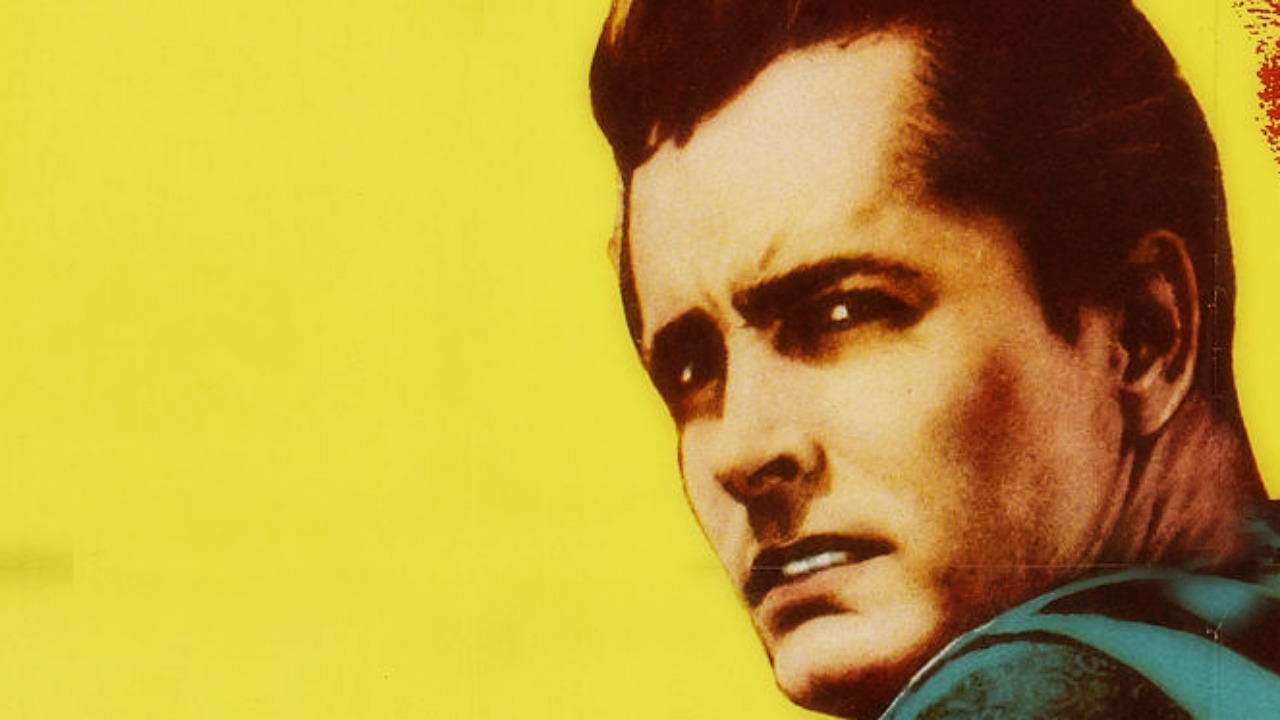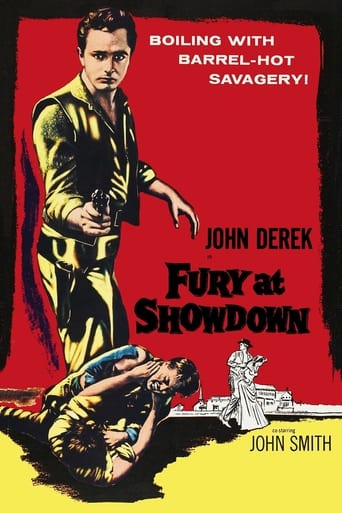



I think this is a new genre that they're all sort of working their way through it and haven't got all the kinks worked out yet but it's a genre that works for me.
View MoreWhat makes it different from others?
It's a mild crowd pleaser for people who are exhausted by blockbusters.
View MoreExactly the movie you think it is, but not the movie you want it to be.
View MoreAn excellent director (Gerd Oswald, who also directed A Kiss Before Dying), excellent cinematographer Joseph LaShelle (River of No Return and Marty among many others) and great performances by John Derek and Nick Adams make this an outstanding western. Derek is Brock Mitchell a rancher who was just released from jail, where he was because he killed a man in self defense. Nick Adams is Tracy, his brother. The fact is that the man Brock killed is the brother of an important man in town who will do everything he can against him. One way out would be for Brock to go away to a distant place, but there are certain reasons for him to stay, like paying the loan Tracy took to develop the ranch, which will not be difficult considering the railroad is going to pass there. It will be just a question of getting a letter from the railroad confirming the deal, but time is running against them. Another reason is that Brock loves Ginny, whose father is against him because he thinks he killed because of jealousy. One more reason is that Brock needs the sense of belonging, that he feels in his home town. There is a heavy ambiance, increased by the black and white cinematography.
View MoreThe United Artists' release "Fury at Showdown" ranks as one of the great unsung westerns of the 1950s. John Derek stars as Brock Mitchell, a combustible young gunslinger who matures over the course of the 75 taut minutes that constitute this well-done tale of revenge. Like most westerns during the 1950s, "Fury at Showdown" emphasizes the message that being a gunslinger is not an appropriate way of living. A young Nick Adams provides solid support as Derek's brother and a pre-"Laramie" John Smith delivers a finely-tuned performance as a slimy gunman. The real scene stealer in this interesting western is naturally the city slicker villain, a well-tailored but older lawyer, Cage Clarke of "The Bad Seed" as conniving Chad Deseasy. Filmed in only five days by "A Kiss Before Dying" director Gerd Oswald, "Fury at Showdown" is a lean, mean western that squanders nary a second. Thoroughly minor in every respect, this movie is nevertheless a very good example of low-budget film-making with spartan black & white lensing by eight-time Oscar nominated cinematographer Joseph LaShelle, who won an Oscar for shooting the 1944 noir masterpiece "Laura" with Dana Andrews and Gene Tierney. LaShelle's cameras are always in the right place at the right time so that you get a physical feel for Oswald's intricate staging of the action. Get out the way Oswald stages the scene in the doctor's office for Nick Adams death scene. Although "Fury at Showdown" was not a big, star-studded oater, the film emerges as a pressure-cooker of attention with its plot a variation on "High Noon."This frontier saga unfolds in the small town of Buckhorn as the sheriff (Tom McKee of "The Steel Jungle") releases fiery young Brock Mitchell (John Derek of "The Outcast") from his jail after the latter has completed a year's sentence for manslaughter. Friends of the man that Mitchell killed in a gunfight await him outside of the jail along with his unarmed younger brother Trace (Nick Adams of "King Creole") who has come to take his big brother home to the family ranch near Showdown Creek. After they reach the ranch, Trace explains how he was able to run the spread after his father died. He took out a $5-thousand dollar loan from the local bank. It seems that beef prices are up and Trace along with two other local ranchers have convinced a representative of the railroad, Mr. Phelps (Ken Christy of "Utah Blaine") to launch a spur line onto their property so that they can get their livestock to market. Not only with this spur railway help Trace pay off the note, but also they will have money left over from the deal. The villainous Chad Deseasy resolves to destroy the Mitchells. As the director and a stock holder of the Cattleman's Trust Bank, Deseasy doesn't want to renew Trace's note and the deadline to pay off the note is rapidly approaching. In fact, they have three days. Initially, Trace and the others think that Phelps will show up in Showdown Creek and ink the deal, but day after day passes with no sign of Phelps. Our protagonists know that Phelps is in nearby Gunstock, but Trace's partners in the deal are leery of his hot-headed older brother. Bluntly, they don't trust Brock. Simultaneously, Deseasy has hired a bodyguard, gunslinger Milly Sutton, who is already looking forward to his next job in Durango. Craftily, Deasey sets about to turn the entire town against Brock. Brock turns out to be his own worst enemy because he plays into Deasey's hands for easily, arousing the wrath of the local lawman, Sheriff Clay (Robert Griffin of "Gunsight Ridge"), who happens to be the father of the girl that Brock once dated. In fact, Brock got into a gunfight over Chad's nasty younger brother and gunned him down. Now, Deasey wants to exact retribution from Brock and he orchestrates his campaign with shrewd touches. About half way through the tightly drawn action, trigger-happy Brock shed his gun belt and begins to show maturity. He resists the urge to turn to violence unless it is thrust upon him as when Sutton goads him into a furniture destroying fisticuffs in the saloon. The saloon in "Fury at Showdown" is unlike most in that its bar is curbed like the letter W. Brock and Sutton virtually tear the place down. They smash the mirror behind the bar, wreck furniture, and crash through a window. They get tangled up in a horse drawn buckboard and as the vehicle is careening away from the scene we see Brock disengage himself. It looks like Derek and Smith performed their own stunts in the saloon brawl. The saloon brawl is about as far out as Oswald lets this western roam; the remainder of the time he keeps things tightly-knit. The suspense about the arrival of Phelps and the way that the two other partners mistrust Brock fuel the suspense and tension in this nifty little western drama.Derek is in fine shape as the hero who grows over the length of the film, while Nick Adams is the innocent young sacrificial goat. Actually, there isn't a bad performance in this taut western. Gerd Oswald's direction, a sturdy credible cast, LaShelle's exceptional black & white photography, and scenarist Lucas Todd's quotable script make "Fury at Showdown" a first-rate, suspenseful sagebrusher.
View MoreIt would be easy to characterize the film as a brother out for revenge Western but it's more complex than that. In fact the movie surprises with a whole lot more attention to detail than you'd expect from a 1950's effort, from Brock's extended barroom brawl to the place names depicted on the businesses of Showdown Creek. I was particularly intrigued by the presence of the Lin Yee Chinese Dining Room, even if the Mitchell brothers never made it there. They thought about it though.What IS standard is the set up between town lawyer Deasey (Gage Clark) and Brock Mitchell (John Derek), recently released from the Buckhorn County Jail for killing Deasey's brother in a forced gunfight that occurred before the picture opens. Derek portrays the same kind of hot head he played in 1949's "Knock On Any Door", his first lead role in company with Humphrey Bogart. Deasey is clever enough to use just about any mis-step by Brock to turn town sentiment against him, beginning with the Tom Williams incident. Brock simmers in a slow boil for most of the story, as more rational younger brother Tracy (Nick Adams) tries to steer him to make the right decisions along the way. The pairing of Adams and Derek as brothers was really quite a neat casting decision; they complemented each other nicely and appeared believable as siblings.More on that barroom brawl - it's probably one of the longest one on one fight scenes you'll ever see in a Western, and it looked authentic from start to finish. You wondered how the smaller Brock Mitchell would come out against Deasey's hired henchman Miley Sutton (John Smith), but there was enough furniture on hand to provide the equalizer. The spill out into the street leading to the buckboard drag is probably the most creative finale you'll see, but then they still kept going at it. You know, I had to chuckle when the fight got started, the first thing to go was the large mirror behind the bar. Watching the picture on the Encore Western Channel, one of the True Western Moments iterated by Bob Boze Bell in between movies talks about how scenes just like that were more the stuff of Hollywood invention than the real thing.As the story progresses, the viewer learns just how greasy a character Chad Deasey is; say now, greasy Deasey, that works. Not only was he constantly undermining Brock, but he detained railroad man Phelps with a phony letter and indirectly caused the death of Tracy. It was fitting that he didn't die in the movie's finale, but would have to face the music after all the facts became known. Good ending, but did you notice? - Miley Sutton's small bag of payoff money turned into enough coins on the street to fill a small strong box!
View MoreExcellent collaboration between Oscar-winning cinematographer Joseph LaShelle and competent director Gerd Oswald tip the scales on the plus side for this B+ western. The big old Columbia western town set never looked more authentic. Dig the dogs harassing the stagecoach horses. The tracking shots and camera set-ups are all A picture quality. Note the use of the extras. Not the usual aimless wandering, but natural and with attitude. We often see the action from their point of view. Good stuff. The story needs it because their ostracizing of the young hero strains credulity. John Derek is a misunderstood hothead who wants to cool off but they won't let him. Very 50s. He and Nick Adams are very good and quite believable as brothers. The action (aka violence) is unpredictable, well-staged and bloody. The good musical score, played mainly by a lonesome harmonica and guitar, is by another Oscar winner, Harry Sukman. Was the last shot a happy accident or planned? It works.
View More